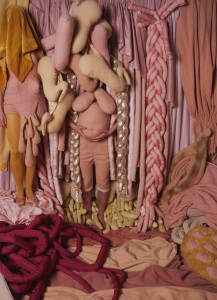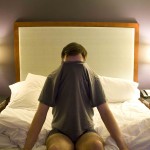All too often fine art photography galleries offer too little beauty and too much ‘concept’. Call me old fashioned, but I want, my artist’s eyes want, to appreciate more than just the exhibit’s concept.
Case in point: the exhibit currently showing at the Colorado Photographic Arts Center (CPAC). Tracing Absence features the current and ongoing works of emerging artists Laura Shill and Adam Milner.

Laura Shill’s work is drawn from her MFA thesis and takes as its point of departure the ghostly ‘hidden mother’ images in century-old tintype photographs of babies. Shill’s installation, as CPAC notes in their announcement, “re-envisions the historic photographer’s studio as a feminine, bodily space.” Her installation, set in an fanciful version of the tintype photographer’s tent, consists of three sets of fifteen images: fifteen tiny matted antique tintypes of babies, fifteen un-matted enlargements of those antique tintypes that reveal the creepy images of draped ‘hidden mothers’ who are holding their squirming babies, and fifteen untitled color prints from Shill’s series Performing the Other. These latter images are ‘portraits’ of strangely costumed individuals, often surrounded by equally strange, organic-motif props; none of the ‘portraits’ reveal the subject’s complete face.
Adam Milner’s installation consists of three distinct but related works: Empty Rooms, Discreet, and Torsos. Milner’s art is inspired by his engaging, as he puts it in his Artist Statement, “in meeting strangers via the internet.” The images in his works are basically photo-stills from some of the video chat sessions with these strangers. Empty Rooms consists of six images of …well… empty rooms—the backdrop and setting of an absent chat partner. Discreet consists of six portraits of male chat partners with their face fully or partially obscured. Torsos consists of 372 iPhone-sized images—arranged in a 12×31 grid—of the bare torsos of other male chat partners.

For CPAC curator Marlow Hoffman, the tie that binds these two very different and highly conceptual bodies of work is the artists’ creation of ‘faceless portraits’. In her curator statement, Hoffman notes that these faceless portraits are connected in that the images simultaneously “reveal and conceal” their subjects, and that the portraits are the “catalyst for the artist’s exploration of identity, gender, conformity and the performance of self.”
Hoffman’s explanation for connecting and exhibiting Shill and Milner’s work in Tracing Absence is all well and good, as far as it goes. Tracing may be an exhibition of art, but for me, something is severely lacking here.
In Tracing, Hoffman, as too many photo curators do these days, has organized something I call a ‘concept-only’ art exhibition. A concept-only art exhibition generally has these characteristics: the viewer must discern the ‘concept’ motivating the photographer if the art is to be appreciated at all; discerning the concept is often difficult to impossible without the crutch of the Artist’s or Curator’s Statement; the exhibition is not a sampling of the photographer’s art but rather the exhibition is the art because the concept is only discernible in the large and not by analysis of individual images.
Most troubling to me is the key characteristic of such exhibitions: to appreciate the art requires the use of eyes, but the art does not intrigue the eyes. Sadly, Tracing is not a feast for the eyes. Not one of Shill’s or Milner’s images caused me to stop and linger. I looked at each image, noted and appreciated its contribution to the overall concept of the exhibition, and quickly moved on.
Taking in the whole, I can agree with Hoffman that the Tracing’s forest of images is art, even if I wonder whether I could say that about its trees. I applaud Hoffman for promoting emerging Colorado photographers, and I encourage patronage of this exhibit if for no other reason than to support her in this effort.
Nevertheless, I left the gallery with my eyes unsatisfied and under-nourished. To my eyes Tracing‘s photographs offer little of beauty, either in form, content or craftsmanship. Tracing offers for appreciation only a ‘concept’, and for me that just isn’t enough. I, and my eyes, want more.
Tracing Absence is showing at CPAC through September 8, 2012.